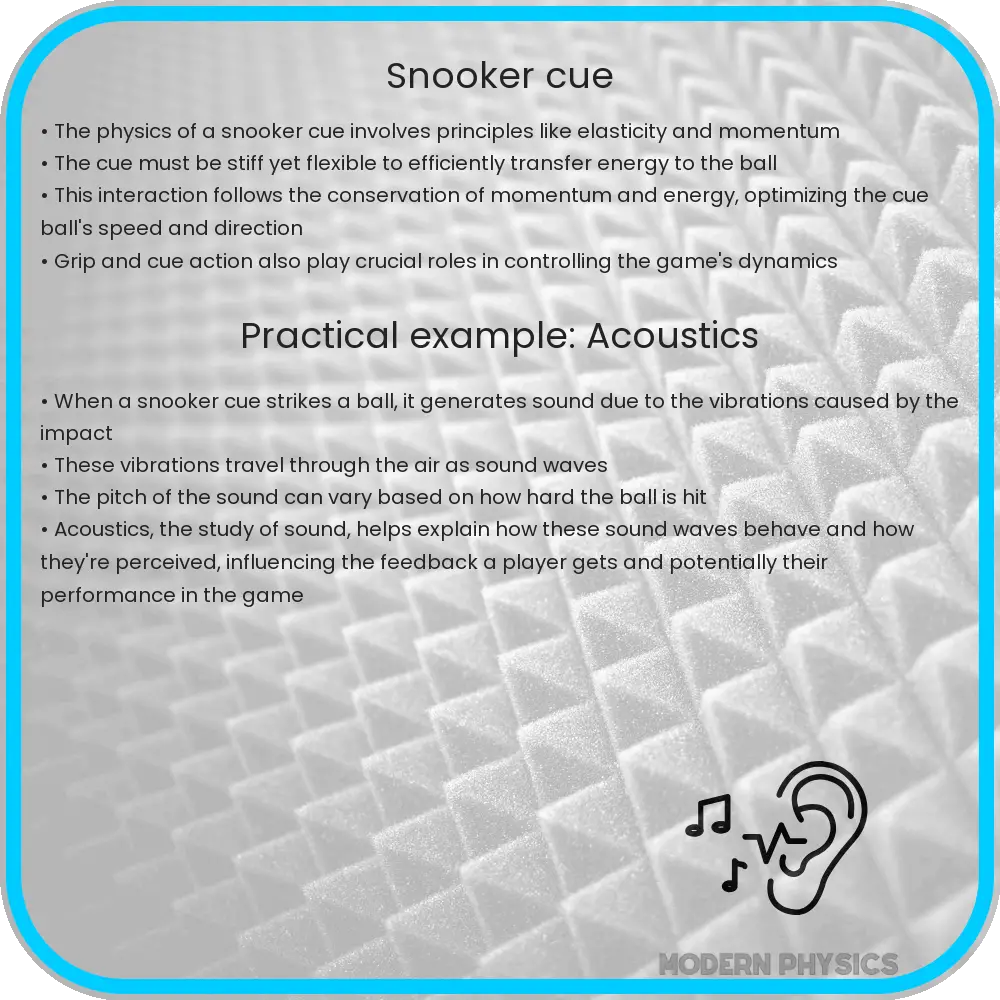Explore the science of snooker cues: Learn how precision, power, and control impact your game, and get tips on cue personalization and maintenance.

Understanding Snooker Cue Dynamics: Precision, Power, and Control
The game of snooker, a test of skill and strategy, hinges on the intricate dynamics of the snooker cue. Understanding these dynamics is essential for mastering the art of snooker. The key elements that define a cue’s performance are precision, power, and control. Each of these aspects is influenced by the cue’s design, material composition, and the player’s technique.
The Science of Precision in Snooker Cues
Precision in snooker refers to the ability to direct the cue ball accurately towards a target. This accuracy is primarily dependent on the cue’s tip and its alignment with the cue shaft. The cue tip, usually made from compressed leather, needs to be perfectly rounded and chalked to ensure a non-slip contact with the ball. The alignment of the tip with the cue shaft affects the cue’s deflection, influencing accuracy. Advanced players often opt for cues with low deflection shafts, which offer more predictable ball paths.
Power: A Matter of Cue Composition
Power in snooker cue dynamics relates to the cue’s ability to transfer energy efficiently to the cue ball. This is largely determined by the cue’s material and weight distribution. Traditional cues are made from ash or maple, known for their rigidity and ability to transmit power effectively. The cue’s weight also plays a critical role; a heavier cue can impart more kinetic energy to the ball, but may sacrifice some control. The ideal weight varies depending on player preference and style.
Control: Balancing Flexibility and Stiffness
Control in snooker cues is about achieving a balance between flexibility and stiffness. A stiffer cue offers more power but can be harder to control, especially for delicate shots. Flexibility, on the other hand, offers more feel and feedback but may reduce power. The taper of the cue shaft – its gradual reduction in diameter from the butt to the tip – also impacts control. A gradual taper can offer a more consistent response and is preferred by players who prioritize precision and feel.
The Role of Cue Length and Balance Point
The length of the cue and its balance point are critical for comfort and effectiveness in play. Standard cue lengths range from 57 to 58 inches, suitable for most players. However, taller players may benefit from longer cues. The balance point, usually located around 16 to 18 inches from the butt of the cue, affects how the cue feels in hand. A balance point closer to the butt end can make the cue feel lighter, aiding in control for delicate shots.
Understanding these aspects of snooker cue dynamics helps players make informed choices about their equipment and refine their playing techniques. In the next section, we will delve into the importance of personalization and maintenance of snooker cues, and how these factors influence the overall performance in the game.
Personalizing Your Snooker Cue for Optimal Performance
Personalization of the snooker cue is vital for aligning it with a player’s style and preference. This includes choosing the right tip hardness, cue weight, and grip. Softer tips offer more control and are preferred for finesse shots, while harder tips are better for power shots. The weight of the cue should complement the player’s physical strength and playing style. Additionally, the grip, whether it’s a simple wrap or a more intricate design, should offer comfort and prevent slippage during play.
Maintaining Your Cue for Consistent Performance
Regular maintenance of the snooker cue is crucial for sustaining its performance. This involves keeping the cue straight, regularly cleaning and conditioning the shaft, and replacing the tip when worn out. Exposure to extreme temperatures and humidity can warp the cue, so proper storage is important. A well-maintained cue not only performs better but also enhances the player’s confidence and consistency in the game.
Technological Advancements in Cue Design
Recent advancements in technology have led to the development of cues with innovative materials like carbon fiber and specialized alloys. These materials offer improved strength, consistency, and durability. Moreover, some modern cues are designed with adjustable weight systems and interchangeable shafts, allowing players to customize their cues for different playing conditions.
Conclusion: The Symbiosis of Player and Cue
In conclusion, the dynamics of a snooker cue – precision, power, and control – play a pivotal role in the game’s execution and outcome. A deep understanding of these dynamics, coupled with the right personalization and maintenance, can significantly enhance a player’s performance. It’s important to remember that the cue is an extension of the player; thus, the symbiosis between the player and their cue is fundamental to achieving excellence in snooker. As technology continues to evolve, players have more tools at their disposal to refine their game, but the core principles of cue dynamics remain timeless. Embracing these principles is key to mastering the intricate and rewarding world of snooker.
